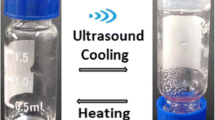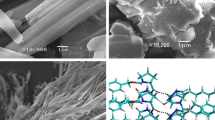Abstract
A series of symmetrical peptidomimetics (3–8) based on cysteine-modified cyclo(L-Lys-L-Lys)s were synthesized, and their gelation capability in organic solvents was dominated by fluorenylmethyloxycarbonyl (Fmoc) and triphenylmethyl (Trt) protecting groups and the exchange of thiol-to-disulfide as well. The peptidomimetics holding Trt (3 and 4) showed no gel performance, while the Fmoc groups promoted 5 and 6 to give rise to thermo-reversible organogels in a number of organic solvents. The self-assembled fibrillar networks were distinctly evidenced in the organogels by transmission electron microscopy (TEM) and scanning electron microscopy (SEM) observations. Fourier transform infrared spectroscopy (FT-IR) and fluorescence analyses revealed that the hydrogen bonding and π-π stacking play as major driving forces for the self-assembly of these organogelators. A β-turn secondary structure was deduced for the organogel of 6 by virtue of X-ray diffraction, FT-IR and circular dichroism (CD) measurements, and an interdigitated bilayer structure was also presented.
Similar content being viewed by others
References
Hanabusa K, Suzuki M. Development of low-molecular-weight gelators and polymer-based gelators. Polym J, 2014, 46: 776–782
Buerkle LE, Rowan SJ. Supramolecular gels formed from multicomponent low molecular weight species. Chem Soc Rev, 2012, 41: 6089–6103
Adams DJ. Dipeptide and tripeptide conjugates as low-molecularweight hydrogelators. Macrom Biosci, 2011, 11: 160–173
**e ZG, Zhang AY, Ye L, Feng ZG. Organo- and hydrogels derived from cyclo(L-Tyr-L-Lys) and its e-amino derivatives. Soft Matter, 2009, 5: 1747–1482
Kar T, Debnath S, Das D, Shome A, Das PK. Organogelation and hydrogelation of low-molecular-weight amphiphilic dipeptides: pH responsiveness in phase-selective gelation and dye removal. Langmuir, 2009, 25: 8639–8648
Dasgupta A, Mondal JH, Das D. Peptide hydrogels. RSC Adv, 2013, 3: 9117–9149
Zhang SG, Marini DM, Hwang W, Santoso S. Design of nano-structured biological materials through self-assembly of peptides and proteins. Curr Opin Chem Biol, 2002, 6: 865–871
Koutsopoulos S, Unsworth LD, Nagai Y, Zhang SG. Controlled release of functional proteins through designer self-assembling peptide nanofiber hydrogel scaffold. Proc Natl Acad Sci USA, 2009, 106: 4623–4628
Zhang YL, Yang B, Xu LX, Zhang XY, Tao L, Wei Y. Self-healing hydrogels based on dynamic chemistry and their biomedical applications. Acta Chim Sinica, 2013, 71: 485–492
Chen J, Wu W, Mc Neil AJ. Detecting a peroxide-based explosive via molecular gelation. Chem Commun, 2012, 48: 7310–7312
Frederix PW, Scott GG, Abul-Haija YM, Kalafatovic D, Pappas CG, Javid N, Hunt NT, Ulijn RV, Tuttle T. Exploring the sequence space for (tri-)peptide self-assembly to design and discover new hydrogels. Nat Chem, 2015, 7: 30–37
Gazit E. Molecular self-assembly: searching sequence space. Nat Chem, 2015, 7: 14–15
Cheng G, Castelletto V, Moulton CM, Newby GE, Hamley IW. Hydrogelation and self-assembly of Fmoc-tripeptides: unexpected influence of sequence on self-assembled fibril structure, and hydrogel modulus and anisotropy. Langmuir, 2010, 26: 4990–4998
Manchineella S, Govindaraju T. Hydrogen bond directed self-assembly of cyclic dipeptide derivatives: gelation and ordered hierarchical architectures. RSC Adv, 2012, 2: 5539–5542
Mash EA. Crystal engineering with 1,4-piperazine-2,5-diones. Cryst Eng Comm, 2014, 16: 8620–8637
Borthwick AD. 2,5-Diketopiperazines: synthesis, reactions, medicinal chemistry, and bioactive natural products. Chem Rev, 2012, 112: 3641–3716
Hanabusa K, Matsumoto M, Kimura M, Kakehi A, Shirai H. Low molecular weight gelators for organic fluids: gelation using a family of cyclo(dipeptide)s. J Colloid Interf Sci, 2000, 224: 231–244
Delatouche R, Durini M, Civera M, Belvisi L, Piarulli U. Foldamers of bifunctional diketopiperazines displaying a ß-bend ribbon structure. Tetrahedron Lett, 2010, 51: 4278–4280
Hoshizawa H, Minemura Y, Yoshikawa K, Suzuki M, Hanabusa K. Thixotropic hydrogelators based on a cyclo(dipeptide) derivative. Langmuir, 2013, 29: 14666–14673
Sasaki Y, Akustu Y, Matsui M, Suzuki K, Sakurada S, Sato T, Kisara K. Studies on analgesic olgopeptides. II. Structure-activity relationship among thirty analogs of a cyclic dipeptide, cyclo(Tyr-Arg). Chem Pharm Bull, 1982, 30: 4435–4442
**e ZG, Zhang AY, Ye L, Wang X, Feng ZG. Shear-assisted hydrogels based on self-assembly of cyclic dipeptide derivatives. J Mater Chem, 2009, 19: 6100–6102
a)_Majó MA, Bou JJ, Herranz C, Muñoz-Guerra S. Polycondensation of L-lysine diketopiperazine with tartaric acid—evidence on the formation of cyclic oligomers. Macromol Chem Phys, 2006, 207: 615–620
Zong QY, Geng HM, Zhang AY, Ye L, Wang X, Feng ZG. A study on synthesis and gelation capability of Fmoc and Boc disubstituted cyclo(L-Lys-L-Lys)s. Acta Chim Sinica, 2015, 73: 423–430
a)_Kaur N, Zhou B, Breitbeil F, Hardy K, Kraft KS, Trantcheva I, Phanstiel O IV. A delineation of diketopiperazine self-assembly processes understanding the molecular events involved in N-(Fumaroyl)- dike-topiperazine of L-lys (FDKP) Interactions. Mol Pharm, 2007, 5: 294–315
Geng HM, Zong QY, Zhang AY, Ye L, Wang X, Feng ZG. Synthesis of cyclo(L-Lys-L-Lys)-based organogelators and their applications for phase-selective gelation and dye adsorption. Chin J Appl Chem, 2015, doi: 10.11944/j.issn.1000-0518.2015.08.140423
Fleming S, Ulijn RV. Design of nanostructures based on aromatic peptide amphiphiles. Chem Soc Rev, 2014, 43: 8150–8177
Yang ZM, Gu HW, Fu DG, Gao P, Lam GK, Xu B. Enzymatic formation of supramolecular hydrogels. Adv Mater, 2004, 16: 1440–1444
Shao H, Parquette JR. A π-conjugated hydrogel based on an Fmocdipeptide naphthalene diimide semiconductor. Chem Commun, 2010, 46: 4285–4287
Smith AM, Williams RJ, Tang C, Coppo P, Collins RF, Turner ML, Saiani A, Ulijn RV. Fmoc-diphenylalanine self aßsembles to a hydrogel via a novel architecture based π-π interlocked ß-sheets. Adv Mater, 2008, 20: 37–41
Nguyen MM, Eckes KM, Suggs LJ. Charge and sequence effects on the self-assembly and subsequent hydrogelation of Fmoc-depsipeptides. Soft Matter, 2014, 10: 2693–2702
**e ZG, Zhang AY, Ye L, Feng ZG. Synthesis and gelation of a series of low-molecular-weight gelators based on fmoc-dipeptide in alcoholic solvents. Acta Chim Sinica, 2008, 23: 2620–2624
Dou X, Li P, Zhang D, Feng CL. C2-symmetric benzene-based hydrogels with unique layered structures for controllable organic dye adsorption. Soft Matter, 2012, 8: 3231–3238
Tang C, Ulijn RV, Saiani A. Effect of glycine substitution on Fmoc–diphenylalanine self-assembly and gelation properties. Langmuir, 2011, 27: 14438–14449
a)_Xu XD, Chen CS, Lu B, Cheng SX, Zhang XZ, Zhuo RX. Coassembly of oppositely charged short peptides into well-defined supramolecular hydrogels. J Phys Chem B, 2010, 114: 2365–2372
Schweitzer D, Hausser KH, Haenel MW. Transanular interaction in [2.2] phanes; [2.2] (4,4′) diphenylophane and [2.2] (2,7) fluorenophane. Chem Phys, 1978, 29: 181–185
a)_Wang HM, Yang CH, Tan M, Wang L, Kong DL, Yang ZM. A structure-gelation ability study in a short peptide-based “Super Hydrogelator” system. Soft Matter, 2011, 7: 3897–3905
Gosal WS, Clark AH, Pudney PDA, Ross-Murphy SB. Novel amyloid fibrillar networks derived from a globular protein: beta-lactoglobulin. Langmuir, 2002, 18: 7174–7781
Gosal WS, Clark AH, Pudney PDA, Ross-Murphy SB. Fibrillar beta-lactoglobulin gels: Part 1. Fibril formation and structure. Biomacromolecules, 2004, 5: 2408–2419
Zhu P, Yan X, Su Y, Yang Y, Li J. Solvent-induced structural transition of self-assembled dipeptide: from organogels to microcrystals. Chem Eur J, 2010, 16: 3176–3183
a)_Nalluri SK, Shivarova N, Kanibolotsky AL, Zelzer M, Gupta S, Frederix PW, Skabara PJ, Gleskova H, Ulijn RV. Conducting nanofibers and organogels derived from the self-assembly of tetrathiafulvalene- appended dipeptides. Langmuir, 2014, 30: 12429–12437
Tang C, Smith AM, Collins RF. Fmoc-diphenylalanine self-assembly mechanism induces apparent pKa shifts. Langmuir, 2009, 25: 9447–9453
Dave N, Troullier A, Mus-Veteau I, Dunach M, Leblanc G, Padros E. Secondary structure components and properties of the melibiose permease from escherichia coli: a fourier transform infrared spectroscopy analysis. Biophys J, 2008, 78: 747–755
Koch O. Advances in the prediction of turn structures in peptides and proteins. Mol Inf, 2012, 31: 624–630
Gunasekaran K, Gomathi L, Ramakrishnan C, Chandrasekhar J, Balaram P. Conformational interconversions in peptide ß-turns: analysis of turns in proteins and computationnal estimates of barriers. J Mol Biol, 1998, 284: 1505–1516
Tena-Solsona M, Miravet JF, Escuder B. Tetrapeptidic molecular hydrogels: self-aßsembly and co-aggregation with amyloid fragment Aß1-40. Chem Eur J, 2014, 20: 1023–1031
John G, Masuda M, Yoshida K, Shinkai S, Shimizu T. Self-assembly of a sugar-based gelator in water: its remarkable diversity in gelation ability and aggregate structure. Langmuir, 2001, 17: 7229–7232
Author information
Authors and Affiliations
Corresponding author
Electronic supplementary material
Rights and permissions
About this article
Cite this article
Geng, H., Zong, Q., You, J. et al. Gelation capability of cysteine-modified cyclo(L-Lys-L-Lys)s dominated by Fmoc and Trt protecting groups. Sci. China Chem. 59, 293–302 (2016). https://doi.org/10.1007/s11426-015-5477-8
Received:
Accepted:
Published:
Issue Date:
DOI: https://doi.org/10.1007/s11426-015-5477-8




